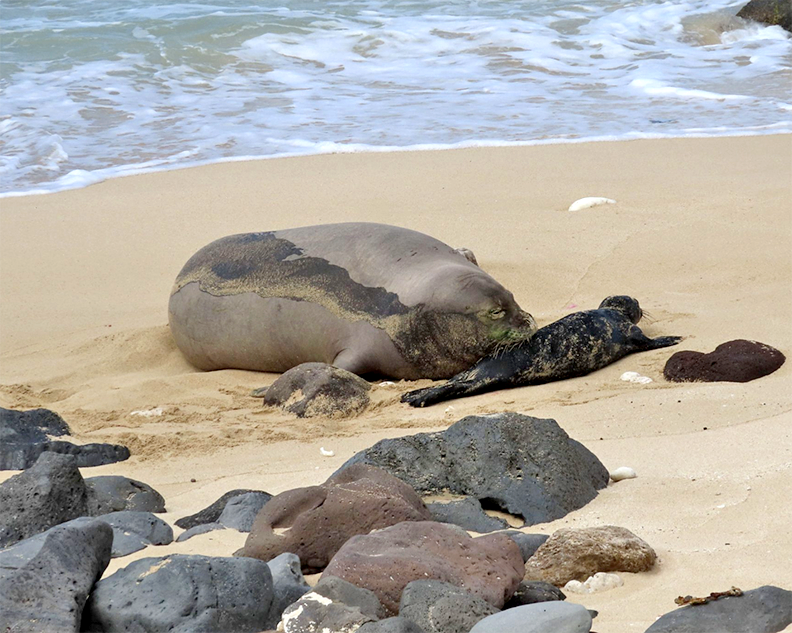By Léo Azambuja

A North Shore sunset. Photo by Liz Belfor/Images by Liz
The heat is on. I’m not talking about a 1980s pop song by the late Glenn Frey, one of the original members of the Eagles. The heat is really on. It’s merciless and will cost many lives unless we do something to significantly cut down carbon emissions.
In June, Hawai‘i Gov. David Ige signed a couple bills aligning with the Paris Climate Agreement, and Kaua‘i Mayor Bernard Carvalho Jr. signed a proclamation supporting the agreement. The argument their acts were symbolical may be true; not matter what, our children and grandchildren will likely inherit an unbearably hot world. But we should still do our part to reduce carbon emissions and also press elected officials to do the same through new laws and policies.
A University of Hawai‘i study published in Nature Climate Change in June estimates 74 percent of the world’s population will be exposed to deadly heatwaves by 2100 if carbon gas emissions keep rising at current rates. Cutting down carbon emissions aggressively will help, but 48 percent of people in the world would still be affected by deadly rising temperatures, according to the study.
Camilo Mora, associate professor of geography in the College of Social Sciences at UH Mānoa and lead author of the study said in a UH article, “We are running out of choices for the future.”
“For heatwaves, our options are now between bad or terrible,” Mora said, adding many around the world are already paying the ultimate price of heatwaves, and while models suggest this will likely continue, it can become much worse if emissions are not considerably reduced.
There is something we could learn from recent history. The 2003 European heatwave killed approximately 70,000 people, the 2010 Moscow heatwave killed 10,000 people and the 1995 Chicago heatwave killed 700 people, according to the UH article.
For the study, Mora led a team of researchers through a wide-ranging review of more than 30,000 relevant publications. They found more than 1,900 cases of locations worldwide where high temperatures have killed people since 1980. They looked at dates for 783 lethal heatwaves in 164 cities across 36 countries, with most cases recorded in developed countries at mid-latitudes. Some of the cities with lethal heatwaves included New York, Washington, Los Angeles, Chicago, Toronto, London, Beijing, Tokyo, Sydney and São Paulo.
UH Mānoa graduate and study co-author Farrah Powel said in the article that “finding a threshold beyond which climatic conditions turn deadly is scientifically important yet frightening.” The threshold, she said, will allow scientists to identify conditions harmful to humans. Because the study takes data from actual events, it makes it more credible. The scary thing, she said, is how common “deadly conditions” are already.
According to the study, by 2100, New York will have about 50 days of a deadly climate threshold. Sydney will have 20 days of deadly conditions, and Los Angeles will have 30 days of it. Orlando and Houston will have summer-long deadly conditions.
However, the greatest risk will be in tropical areas, which are hot and humid all year. The state of Hawai‘i is only a few degrees south of the Tropic of Cancer, enough to put us in high alert.

Léo Azambuja
“With high temperatures and humidities, it takes very little warming for conditions to turn deadly in the tropics,” said co-author Iain Caldwell, a post-doctoral researcher at UH Mānoa, in the article. He added warming in the tropics is what will pose the greatest risk to people.
Mora said climate change “put humanity on a path that will become increasingly dangerous and difficult to reverse if greenhouse gas emissions are not taken much more seriously.” Actions such as the withdrawal from the Paris agreement is a step in the wrong direction, he said, delaying fixing a problem for which there is no time to waste.
“The heat is on, on the street … The pressure’s high, just to stay alive. ‘Cause the heat is on,” Frey sang on his hit. We may have danced to it a few, or many, times. But when the heat really hits us, we won’t be dancing at all. Some of us may actually never dance again.
Despite — and because of — a dim hope, we should more than ever support cutting carbon emissions in any way we can.
Discover more from ForKauaiOnline
Subscribe to get the latest posts sent to your email.




Leave a Reply